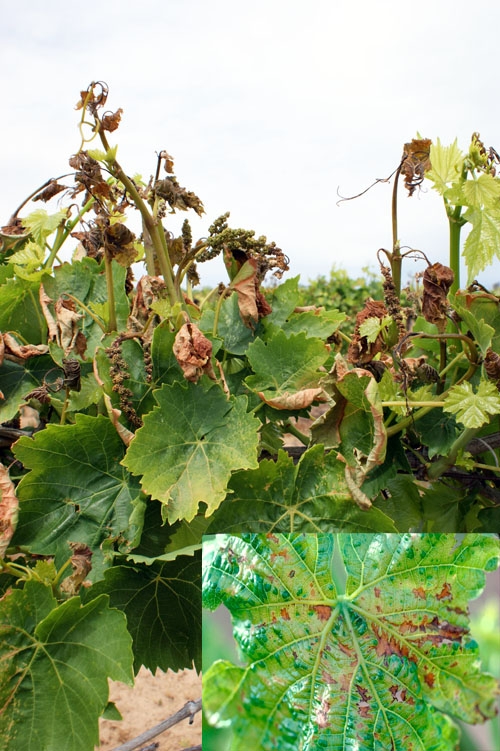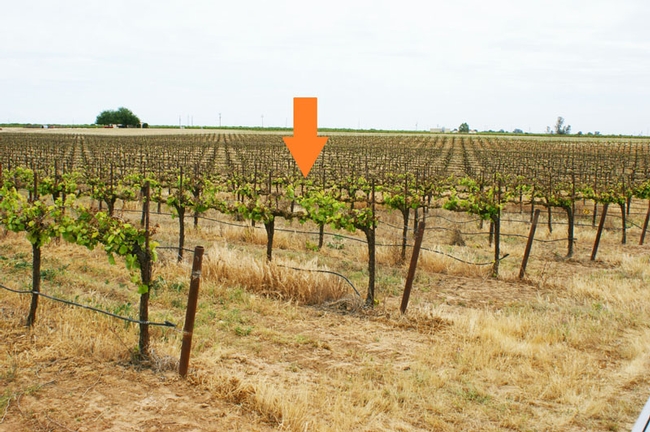Low temperatures experienced during the winter do not usually damage dormant grapevines in the San Joaquin Valley. However, succulent green shoots are much more sensitive to low temperatures, so spring frost damage is serious concern. Damage from spring frost can vary within and between vineyards. Some factors that determine the extent and severity of frost damage include vineyard location, stage of shoot growth, the minimum temperature reached, and the duration of time that the tissues are at or below critical temperatures (Table 1). A mild frost shortly after budbreak may only damage a few leaf cells, causing necrotic (brown to black) spots (Fig. 1, inset) which will appear to be unevenly distributed throughout the leaf blade or shoot. If enough cells are damaged, the leaves may become distorted, or killed. As frost intensity and duration increases, shoot tips and flower clusters may be killed (Fig. 1). Vines in low lying areas of a vineyard will experience the most damage since cold air will settle and not warm until late morning or later (Fig. 2). Severe frosts will kill entire shoots to the cane. When temperatures are low enough to kill whole shoots, the damage is often uniform throughout the vineyard. Shoots killed by frost will turn a dark brown to black color within a few days of freezing.
On clear nights when frost forms, the coldest air is found near the ground. As night progresses, a cool layer of air continues to build and the shoots nearest the ground are the first to experience damage. Thus, training grapevines to higher heights decreases their susceptibility to frost damage. For example, a Thompson Seedless vineyard trained to a height of three feet will be more susceptible to frost than one trained to a height of four feet.
Previous research has shown that temperatures during radiative freezes generally increase with height above ground before decreasing again at some height to form an inversion layer. For example, air temperature may be 28°F one foot above ground, but 30°F three feet above ground. At twenty to twenty-five feet above the soil line the temperature will gain another two degrees. The greater the temperature change between the soil line and the inversion layer, the greater the chance of avoiding frost damage. Wind machines can help mix the cold and warm air, increasing the temperature and providing relief for green tissue.
When frost has been predicted, growers should take note of their vineyard’s growth stage so a strategy can be developed. Vineyards that are not yet at bud break may not require special attention. However, when green shoots are longer than six inches, soils need to be prepared well in advance of cold weather. Table 1 shows the relative susceptibility of grapevine tissue at different growth stages and critical temperatures.
Table 1. Frost damage to various growth stages of grape.
|
Growth Stage |
Critical Temperature* |
|
Buds—tight, closed |
25-27°F |
|
Buds with wool (eraser stage) |
< 26°F |
|
Budbreak—green tissue showing |
< 30°F |
|
Shoots< 6” in length |
< 31°F |
|
Shoots > 6” in length |
< 32° |
*Critical temperatures are based on research under controlled environments. Vineyard characteristics (location, cultivar, etc.) may increase or decrease susceptibility to frost damage. These values should only be used as a point of reference when developing a frost protection program.
If a significant frost event occurs and all the green shoots are killed, secondary or tertiary buds will push within one to two weeks. However, secondary and tertiary buds will not be as fruitful as the primary buds and growers can expect substantial losses. Vineyards that have experienced significant frost damage should be irrigated regularly in order to develop a full canopy and prepare them for the following season. Vineyards with substantial frost damage should not be neglected.
Soil Characteristics
In order to minimize damage caused by frost, vineyard soils should be prepared for maximum heat absorption during the day and release at night. Optimal conditions include soils that are free of vegetation, firm in texture, and moist. Moist dark soils improve their ability to absorb heat during the day and radiate it at night as ambient temperatures drop. Soil texture will also have an impact on heat absorption. Vineyards planted to sandy soils are more prone to frost damage because they retain less water. Additional water may be needed if winter precipitation has not been adequate to maintain soil moisture. Prior to a predicted frost, the goal should be a uniformly distributed irrigation that allows for maximum heat absorption. Table 2 shows the benefits of a bare, firm moist soil in contrast to less optimal vineyard floor conditions. Soils that have been recently cultivated or disked do not retain heat well because they are dry and have numerous air pockets and thus should be irrigated soon after cultivation. Native vegetation or cover crops that insulate soils from absorbing heat should be mowed, disked, and irrigated, unless significant precipitation makes irrigation unnecessary. Irrigation during a frost event can be beneficial. On nights that low temperatures are expected pumps should be turned on early enough that the entire vineyard is covered with water. In some vineyards, it may not be feasible to saturate the whole vineyard. In such cases, focus efforts on the most susceptible areas (low lying) portions where cold air tends to drain. Doing so will improve the chances of protection.
Vineyards that are drip irrigated should not have their row middles cultivated. Drip irrigation should be turned on to wet as much soil as possible. Growers will have to be especially vigilant to the weather forecast in order to start irrigating well in advance of the frost event. Cover crops or native vegetation should be mowed prior to budbreak and regularly thereafter until the risk of frost has passed (typically mid-April). Row middles should not be cultivated unless a significant rain event has been predicted. Doing so could result in significant losses if frost should occur. It only takes a single frost event (one night at freezing or below) to experience a complete loss.
Table 2. Comparisons between optimal soil conditions for frost.
|
Soil Characteristics |
Vegetation |
Temperature Benefit |
|
|
Bare, firm, moist |
None |
Warmest |
Optimal ↓ ↓ Least optimal |
|
Moist |
Shredded cover crop |
0.5 °F |
|
|
Moist |
Low growing cover crop |
1-3 °F colder |
|
|
Dry, firm |
Freshly disked |
2 °F colder |
|
|
Dry to moist |
High cover crop |
2 °F colder |

